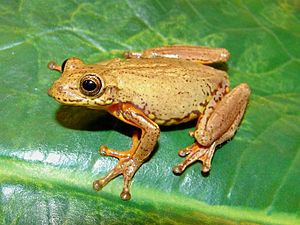Dendropsophus bogerti facts for kids
Quick facts for kids Dendropsophus bogerti |
|
|---|---|
 |
|
| Conservation status | |
| Scientific classification | |
| Synonyms | |
|
Dendropsophus bogerti is a type of frog that belongs to the Hylidae family. This frog lives only in the Andes mountains of Colombia. You can find it in the central mountain range, in places like Antioquia, Caldas, and Chocó Department.
The name bogerti was given to honor Charles Mitchill Bogert. He was an American scientist who studied reptiles and amphibians. For a while, scientists thought this frog was the same as another species. But in 1997, they confirmed it was its own unique species again.
Contents
What Does It Look Like?
Adult male Dendropsophus bogerti frogs are about 2.5 to 2.6 centimeters (about 1 inch) long. Adult females are a bit bigger, around 3.1 centimeters (about 1.2 inches) long. Their snout, or nose area, is short and rounded.
The frog's eardrum, called the tympanum, is very hard to see. Their fingers have some webbing at the bottom. Their toes are more than half webbed, which helps them swim.
The colors of these frogs are different for males and females.
- Males are a dull yellowish-green on their backs and limbs.
- Females are pale golden-brown or beige.
The hidden parts of their legs are bright orange. Their throat is bright yellow. Their belly and the lower back part of their sides are pale brownish-yellow. The frog's eye, or iris, is a coppery color.
Baby Frogs (Tadpoles)
The tadpoles of Dendropsophus bogerti have a body shaped like an oval. It is wider than it is tall. Their body is dark brown. It has shiny blue, gold, and purple colors near the front. You can also see golden spots on their back. Their fins are coppery brown. The tail narrows quickly to a distinct whip-like end. Tadpoles that are about to change into frogs are around 1.4 to 1.5 centimeters (about 0.5 inches) long. This is about 41% of their total length, including the tail.
Where It Lives and How It's Protected
Dendropsophus bogerti is a frog that can live in many different places. It likes open areas, such as forests that are growing back after being cut down. It also lives in pasturelands, which are fields where animals graze. These frogs are found at heights between 1,500 and 2,580 meters (about 4,900 to 8,500 feet) above sea level.
The female frogs lay their eggs in pools of water. These can be pools that are only there for a short time or pools that are always there. This frog species is very common. Scientists do not think it is facing any major threats right now. However, it has not been found living in any protected natural areas.
See also
 In Spanish: Dendropsophus bogerti para niños
In Spanish: Dendropsophus bogerti para niños


